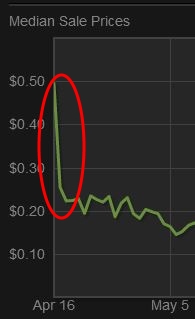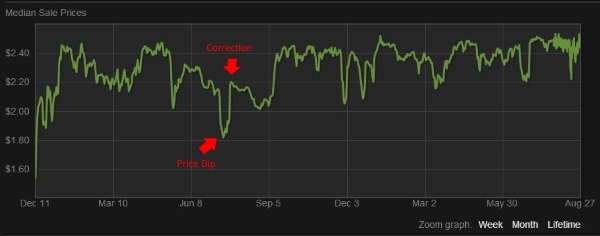Did you miss page one? Click the link above to check it out.
Riding the wave
It may surprise you to know that Valve (the creators of Steam) actually consulted with a professor a few years back to better understand their digital marketplace dynamics. Professor Varoufakis went on to write several articles on the subject, among them a very interesting analysis of the economics of game items. In it, Varoufakis concluded that there is arbitrage in the Steam market, and that it can be profitable, especially in the time before the community has determined how to price an item. In practice I find these opportunities to be relatively short in duration and fairly low in trade volume, hence my opinion that you can't quit your job to become a Steam day-trader... but that doesn't mean you can't make a few bucks.

Sell in the spike
First of all, you can note that for almost every item on the Steam marketplace, there is a huge initial spike in pricing that takes some time to correct. I don't know whether it is due to Elijah Wood making it rain to have the newest shiny items, or because some OCD basement-dweller has to collect them I don't know. Surely there is an element of confusion in the market before rational pricing can be established as well - but whatever the reason, the spike always seems to exist. Given this fact rule number one is: Sell during the spike if at all possible. A great example of putting this into practice is to sell the first trading card you earn in a Steam Sale immediately.
Pro Tip If you are prepared for the sale, you've likely set aside some other sets of non-Sale Trading Cards for badge-craftage. Plan to cash in all or most of these on the first day of the Sale to get early Sale Trading Cards that you can sell while the price is high.

Elliott and his Waves
Past the first spike, things get a great deal more murky. There is certainly no exact science here, but there has been a great deal of research on the extent to which future price behavior is predictable, based on crowd psychology. In particular, there was a famous economist from the late 19th century named Ralph Nelson Elliott who theorized that price behavior follows a wave pattern which can be predicted to some extent. I would definitely not bet my life savings on this theory, but when you think about it, it does make sense that there is some predictability to how a crowd will act when presented with certain stimuli. As such, when looking at pricing trends, try to think a little farther into the future and make bets on where you think the price is likely to ultimately end up. Barring certain caveats, if the price is climbing fast it is likely to correct lower at some future point, and if it is falling like a stone you might wait for a rebound before selling.
Getting out
Certain items, especially those associated with Steam Sales, have a shot clock that ticks down. In the closing hours of the sale, these items will fall in price like a stone, because their real value for crafting badges and other sale items is about to go to zero. Take note of the important time milestones of a sale, and be sure to sell your items before the fire sale. Conversely, if you for whatever reason want to buy said items (say, just to collect), the closing hours of the Sale are a great time to buy them at a fraction of the cost.
Conclusion
While selling on the Steam Marketplace is unlikely to get you rich, there are some trends and tricks to keep in mind if you do decide to offload some virtual collectables. Armed with this knowledge, you can make a few bucks - which on Steam can go a really long way. Free games, woo!